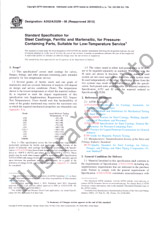Potrebujeme váš súhlas na využitie jednotlivých dát, aby sa vám okrem iného mohli ukazovať informácie týkajúce sa vašich záujmov. Súhlas udelíte kliknutím na tlačidlo „OK“.
ASTM E2885-21
Standard Specification for Handheld Point Chemical Vapor Detectors (HPCVD) for Homeland Security Applications
NORMA vydaná dňa 1.9.2021
Informácie o norme:
Označenie normy: ASTM E2885-21
Dátum vydania normy: 1.9.2021
Kód tovaru: NS-1036349
Počet strán: 15
Približná hmotnosť: 45 g (0.10 libier)
Krajina: Americká technická norma
Kategória: Technické normy ASTM
Kategórie - podobné normy:
Anotácia textu normy ASTM E2885-21 :
This specification establishes baseline performance requirements and additional optional capabilities for handheld point chemical vapor detectors (HPCVD) intended for homeland security applications. It provides HPCVD designers, manufacturers, integrators, procurement personnel, end users/practitioners, and responsible authorities a common set of parameters to match capabilities and user needs. The document specifies chemical detection performance requirements, system requirements, environmental requirements, manuals and documentation, product marking, and packaging.
Keywords:
chemical vapor detector, handheld point chemical vapor detector, HPCVD, homeland security,, ICS Number Code 13.320 (Alarm and warning systems)
Doplňujúce informácie
| 1. Scope | ||||||
|
1.1?General:? 1.1.1?This document presents baseline performance requirements and additional optional capabilities for handheld point chemical vapor detectors (HPCVD) for homeland security applications. This document is one of several that describe chemical vapor detectors (for example, handheld and stationary) and chemical detection capabilities including: chemical vapor hazard detection, identification, and quantification. An HPCVD is capable of detecting and alarming when exposed to chemical vapors that pose a risk as defined by the Acute Exposure Guideline Levels for Selected Airborne Chemicals (AEGL). 1.1.2?This document provides the HPCVD baseline requirements, including performance, system, environmental, and documentation requirements. This document provides HPCVD designers, manufacturers, integrators, procurement personnel, end users/practitioners, and responsible authorities a common set of parameters to match capabilities and user needs. 1.1.3?This document is not meant to provide for all uses. Manufacturers, purchasers, and end users will need to determine specific requirements including, but not limited to, use by HAZMAT teams, use in explosive atmospheres, use with personal protective equipment (PPE), use by firefighters and law enforcement officers, special electromagnetic compatibility needs, extended storage periods, and extended mission time. These specific requirements may or may not be generally applicable to all HPCVDs. 1.2?Operational ConceptsHPCVDs are used to detect, identify, classify, or quantify, or combinations thereof, chemical vapor hazards that pose 30-min Acute Exposure Guideline Level-2 (AEGL-2) dangers. The HPCVD should not alarm to environmental background chemical vapors and should provide low false positive alarm rates and no false negatives. Uses of an HPCVD include search and rescue, survey, surveillance, sampling, and temporary fixed-site monitoring. An HPCVD should withstand the rigors associated with uses including, but not limited to, high- and low-temperature use and storage conditions; shock and vibration; radio frequency interference; and rapid changes in operating temperature, pressure, and humidity. 1.3?HPCVD Chemical Detection CapabilitiesManufacturers document and verify, through testing, the chemical detection capabilities of the HPCVD. Test methods for assessing chemical detection capabilities are available from the Department of Homeland Security and the Department of Defense and are listed in Appendix X3. 1.4?HPCVD System and Environmental PropertiesManufacturers document and verify, through testing, the system and environmental properties of the HPCVD. Example test methods for assessing the system and environmental properties are listed in Appendix X4. 1.5?UnitsThe values stated in SI units are to be regarded as the standard. Vapor concentrations of the hazardous materials are presented in parts per million (ppm) as used in 1.6?This standard does not purport to address all of the safety concerns, if any, associated with its use. It is the responsibility of the user of this standard to establish appropriate safety, health, and environmental practices and determine the applicability of regulatory limitations prior to use. 1.7?This international standard was developed in accordance with internationally recognized principles on standardization established in the Decision on Principles for the Development of International Standards, Guides and Recommendations issued by the World Trade Organization Technical Barriers to Trade (TBT) Committee. |
||||||
| 2. Referenced Documents | ||||||
|
Odporúčame:
Aktualizácia technických noriem
Chcete mať istotu, že používate len platné technické normy?
Ponúkame Vám riešenie, ktoré Vám zaistí mesačný prehľad o aktuálnosti noriem, ktoré používate.
Chcete vedieť viac informácií ? Pozrite sa na túto stránku.




 Cookies
Cookies
